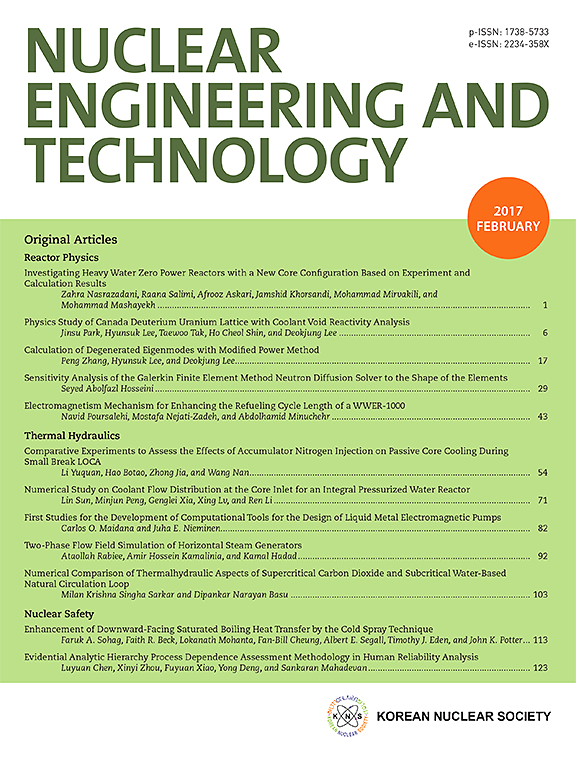Bi2O3 additive effects on gamma radiation shielding properties of 45SiO2-20B2O3-23Na2O3-9CaO-3Al2O3 glass
IF 2.6
3区 工程技术
Q1 NUCLEAR SCIENCE & TECHNOLOGY
引用次数: 0
Abstract
Radiation poses a significant threat to living organisms, necessitating the development of effective shielding materials. This study investigates the properties of glass materials with varying proportions of SiO2 and B2O3, selecting 45SiO2–20B2O3–23Na2O–9CaO–3Al2O3 (mol%) as the base composition. X-ray diffraction analysis confirmed the amorphous nature of the prepared glasses, while differential thermal analysis (DTA) determined glass transition temperatures (Tg). Precise density measurements were conducted to validate the structural findings. Monte Carlo N-Particle (MCNP) simulations were employed to assess the photon energy absorbance characteristics of the glasses, revealing that adding Bi2O3, up to 15 mol% in the GSB2-15 glass, significantly enhances gamma-ray shielding properties. Key results show that increasing Bi2O3 content from 0 to 15 mol% improves photon energy absorption, with the GSB2-15 glass achieving a density of 2.691 g/cm3 and a Tg of 533.19 °C, both superior to those of other compositions. Fourier Transform Infrared (FTIR) and Raman spectroscopy further demonstrated that GSB2-15 maintains structural stability under gamma radiation doses up to 3.98 Gy, with minimal bond disruption. These findings establish the GSB2-15 glass, with 15 mol% Bi2O3, as a highly effective candidate for radiation shielding applications.
Bi2O3添加剂对45SiO2-20B2O3-23Na2O3-9CaO-3Al2O3玻璃屏蔽γ辐射性能的影响
辐射对生物体构成重大威胁,因此有必要开发有效的屏蔽材料。以45SiO2-20B2O3-23Na2O-9CaO-3Al2O3 (mol%)为基料,研究了不同SiO2和B2O3配比下玻璃材料的性能。x射线衍射分析证实了所制备玻璃的非晶性质,而差热分析(DTA)确定了玻璃转变温度(Tg)。进行了精确的密度测量以验证结构发现。采用蒙特卡罗n粒子(MCNP)模拟评估了玻璃的光子能量吸收特性,结果表明,在GSB2-15玻璃中添加高达15 mol%的Bi2O3,显著提高了伽马射线屏蔽性能。关键结果表明,将Bi2O3含量从0增加到15 mol%,可以改善光子能量的吸收,GSB2-15玻璃的密度为2.691 g/cm3, Tg为533.19℃,均优于其他成分。傅里叶变换红外(FTIR)和拉曼光谱进一步证明,GSB2-15在高达3.98 Gy的伽马辐射剂量下保持结构稳定性,键破坏最小。这些发现表明,含有15 mol% Bi2O3的GSB2-15玻璃是一种非常有效的辐射屏蔽应用候选者。
本文章由计算机程序翻译,如有差异,请以英文原文为准。
求助全文
约1分钟内获得全文
求助全文
来源期刊

Nuclear Engineering and Technology
工程技术-核科学技术
CiteScore
4.80
自引率
7.40%
发文量
431
审稿时长
3.5 months
期刊介绍:
Nuclear Engineering and Technology (NET), an international journal of the Korean Nuclear Society (KNS), publishes peer-reviewed papers on original research, ideas and developments in all areas of the field of nuclear science and technology. NET bimonthly publishes original articles, reviews, and technical notes. The journal is listed in the Science Citation Index Expanded (SCIE) of Thomson Reuters.
NET covers all fields for peaceful utilization of nuclear energy and radiation as follows:
1) Reactor Physics
2) Thermal Hydraulics
3) Nuclear Safety
4) Nuclear I&C
5) Nuclear Physics, Fusion, and Laser Technology
6) Nuclear Fuel Cycle and Radioactive Waste Management
7) Nuclear Fuel and Reactor Materials
8) Radiation Application
9) Radiation Protection
10) Nuclear Structural Analysis and Plant Management & Maintenance
11) Nuclear Policy, Economics, and Human Resource Development
 求助内容:
求助内容: 应助结果提醒方式:
应助结果提醒方式:


